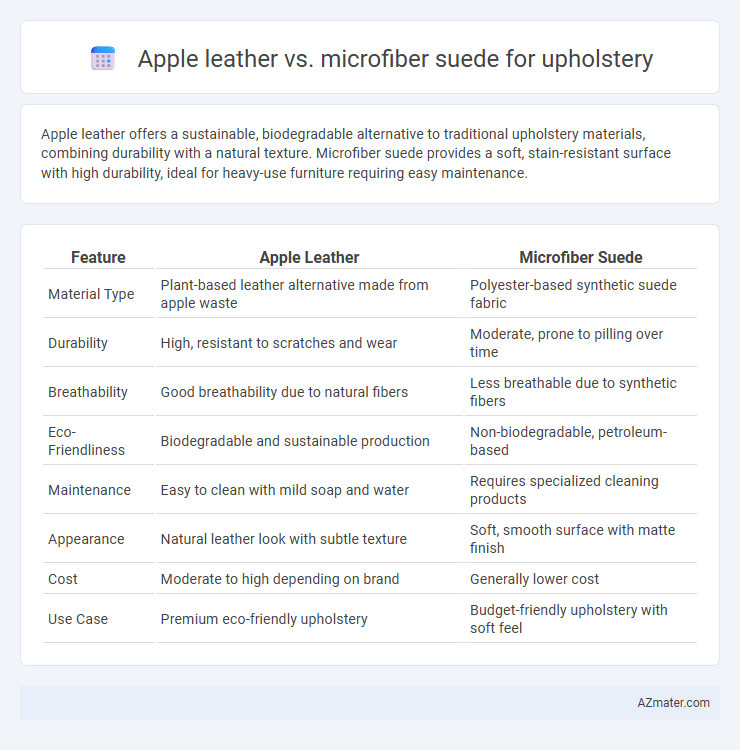Apple leather offers a sustainable, biodegradable alternative to traditional upholstery materials, combining durability with a natural texture. Microfiber suede provides a soft, stain-resistant surface with high durability, ideal for heavy-use furniture requiring easy maintenance.
Table of Comparison
| Feature | Apple Leather | Microfiber Suede |
|---|---|---|
| Material Type | Plant-based leather alternative made from apple waste | Polyester-based synthetic suede fabric |
| Durability | High, resistant to scratches and wear | Moderate, prone to pilling over time |
| Breathability | Good breathability due to natural fibers | Less breathable due to synthetic fibers |
| Eco-Friendliness | Biodegradable and sustainable production | Non-biodegradable, petroleum-based |
| Maintenance | Easy to clean with mild soap and water | Requires specialized cleaning products |
| Appearance | Natural leather look with subtle texture | Soft, smooth surface with matte finish |
| Cost | Moderate to high depending on brand | Generally lower cost |
| Use Case | Premium eco-friendly upholstery | Budget-friendly upholstery with soft feel |
Introduction to Eco-Friendly Upholstery Materials
Apple leather, derived from apple core and peel waste, offers a sustainable alternative to traditional leather with durability and a soft texture ideal for upholstery. Microfiber suede, made from finely woven synthetic fibers, provides a cruelty-free, stain-resistant, and long-lasting option that mimics the feel of genuine suede. Both materials represent eco-friendly innovations in upholstery, reducing environmental impact through renewable resources and lower chemical usage.
What is Apple Leather?
Apple leather is an innovative, sustainable upholstery material made from the byproducts of apple processing, primarily apple peel and core waste, which are transformed into a durable, eco-friendly leather alternative. This vegan leather mimics the texture and appearance of traditional leather while offering superior breathability and resistance to wear and stains, making it ideal for furniture and upholstery applications. Compared to microfiber suede, apple leather provides a more natural, biodegradable option with reduced environmental impact, appealing to environmentally conscious consumers seeking stylish and functional interior materials.
Understanding Microfiber Suede
Microfiber suede upholstery offers exceptional durability and stain resistance, making it a popular choice for high-traffic areas where longevity is essential. Its synthetic fibers mimic the soft texture of natural suede while providing enhanced breathability and easy maintenance compared to traditional materials like Apple leather. The tightly woven microfiber structure also contributes to its resistance against fading and wear, ensuring a consistent appearance over time.
Production Processes: Apple Leather vs Microfiber Suede
Apple leather is crafted from discarded apple peels and cores, which are dried, ground into a powder, and mixed with a polyurethane binder to create a durable, eco-friendly material. Microfiber suede is produced by weaving fine polyester fibers into a dense, soft fabric that mimics natural suede's texture while offering stain resistance and easy maintenance. The production of apple leather emphasizes sustainable waste utilization and lower environmental impact, whereas microfiber suede relies on synthetic fiber manufacturing involving petrochemical processes.
Durability and Longevity Comparison
Apple leather offers a durable and eco-friendly alternative to traditional upholstery materials, with a resistance to wear and tear comparable to genuine leather. Microfiber suede excels in stain resistance and ease of maintenance, providing excellent longevity in high-traffic areas due to its synthetic fibers. Both materials demonstrate strong durability, but apple leather tends to develop a natural patina over time, while microfiber suede maintains a consistent appearance with regular cleaning.
Comfort and Tactile Experience
Apple leather offers a soft, natural feel with breathability and slight texture that enhances comfort in upholstery, mimicking traditional leather while being eco-friendly. Microfiber suede provides a plush, velvety surface with excellent durability and resistance to stains, delivering a consistently smooth and cozy tactile experience. Both materials excel in comfort but differ in texture--Apple leather is more natural and supple, whereas microfiber suede is softer and more uniform.
Environmental Impact and Sustainability
Apple leather, a plant-based material derived from apple waste, offers a sustainable alternative to traditional upholstery fabrics by reducing reliance on animal leather and minimizing agricultural resource use. Microfiber suede, typically made from polyester or nylon fibers, involves synthetic production that consumes non-renewable fossil fuels and contributes to microplastic pollution. Choosing apple leather supports circular economy principles with biodegradable properties, while microfiber suede presents challenges in environmental degradation and end-of-life recyclability.
Maintenance and Cleaning: A Practical Guide
Apple leather offers a durable, water-resistant surface that requires simple wiping with a damp cloth for routine cleaning, making it highly low-maintenance for upholstery. Microfiber suede demands more frequent vacuuming to remove dust and occasional spot cleaning with a mild detergent solution to prevent staining and maintain its soft texture. Both materials benefit from prompt attention to spills, but apple leather's resistance to absorption simplifies long-term upkeep compared to the more delicate care needed for microfiber suede.
Cost Analysis: Apple Leather vs Microfiber Suede
Apple leather offers a sustainable and eco-friendly alternative to traditional upholstery materials, generally priced higher due to its innovative production process and natural ingredients. Microfiber suede is more cost-effective, benefiting from mass production and synthetic fibers, making it a popular budget-friendly choice for upholstery projects. While apple leather commands a premium cost, its durability and environmental benefits can offset long-term expenses compared to the lower upfront price but potentially shorter lifespan of microfiber suede.
Which Upholstery Material is Right for You?
Apple leather offers a sustainable and eco-friendly option for upholstery, made from natural apple waste with a soft texture and excellent durability, ideal for environmentally conscious consumers seeking a stylish yet resilient material. Microfiber suede provides a luxurious feel and stain-resistant properties, making it perfect for high-traffic areas and families with pets or children who prioritize easy maintenance and long-lasting comfort. Choosing between Apple leather and Microfiber suede depends on your preference for sustainability versus practicality, as well as your desired aesthetic and care requirements.

Infographic: Apple leather vs Microfiber suede for Upholstery
 azmater.com
azmater.com